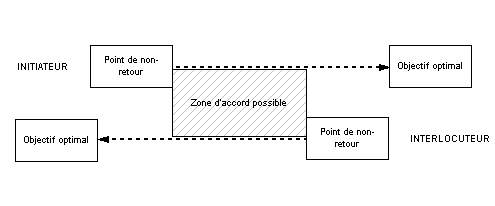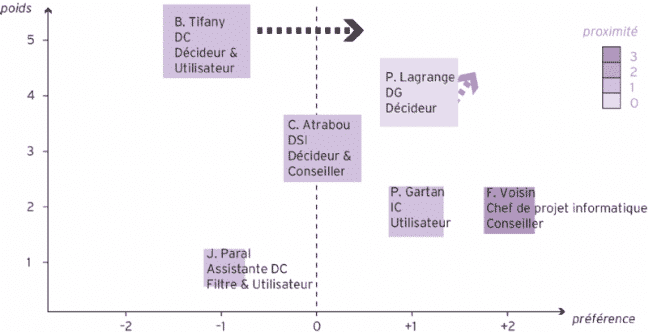If negotiation is an integral part of everyday life, it can become a real art when it comes to professional life. And like any art, commercial negotiation is based on techniques and requires some preparation beforehand.
What are the stages of negotiation? How to make a good negotiation? How to prepare a negotiation? How to make a negotiation plan? How to qualify a negotiation?
This article is a comprehensive guide to help you prepare for your negotiations with confidence: identify the actors, define the negotiating field and your objectives, anticipate the points of confrontation and possible limits, and implement and concretise the result.
Sommaire
What are the main stages of a negotiation?
Before getting into the thick of things, it is important to plan all the stages of the negotiation to anticipate the issues at each stage.

1. Preparing for the negotiation
Before you start negotiating, ask yourself these questions:
- What is the context of this negotiation?
- Who are the people involved and what are their perceptions of the negotiation?
- If conflict, what is the nature of the conflict?
In addition, before any negotiations take place, decide on a time and place for a meeting to discuss the issue: if possible, choose a date close by to clarify the preliminary elements quickly.
Define who will attend and make sure that everyone knows the facts so that they can clarify their position.
Finally, assess their negotiating objectives: what are they likely to ask for?
2. Define the framework of the negotiation
Define the ground rules and procedures for the negotiation with the other parties (and you are not immune to further negotiation on the definition of these rules!)
- Where will it take place?
- Are there any time constraints?
- On what issues will the negotiations be limited?
- What procedure to follow in case of deadlock?
This is also the time when the parties can exchange their first proposals or requests.
3. Discuss and support each other’s positions
After exchanging their initial positions, both parties explain, amplify, clarify, reinforce and justify their initial demands.
But this is not necessarily a confrontation! Rather, it is an opportunity to inform the other party about their perception, and to understand the other’s. It is also a time when each party can ask the other for documentation to support its position.
4. Reconcile & compromise
The essence of the negotiation process lies in the concessions that are made in an attempt to reach an agreement, a good deal. This is where both sides make concessions to reach an agreement.
5. Implement & make it happen
The final stage of the negotiation process is to formalise the agreement that has been drawn up and to develop the necessary procedures for its implementation and monitoring.
In the case of major negotiations, the details should be set out in a formal contract.
In short, these five stages of the negotiation process all need to be negotiated to decide how to allocate limited resources to safeguard everyone’s interests. Being well prepared also allows you to be more confident and then apply our commercial negotiation techniques to make sure you win the negotiation.
Preparing a negotiation well: the ATROCE method

Don’t be fooled by the acronym, the ATROCE method simply allows you to prepare your commercial negotiation methods by following a precise approach:
- Actors: who are the actors?
- Land: what land is being negotiated?
- Power relationship: is it balanced between the parties?
- Objectives: what are your objectives and those of the other parties?
- Confrontation of objectives: are they compatible?
- Stages: have you planned all the stages, from introduction to conclusion? What are the possible incidents?
1. Identify the actors in the negotiation
List all the actors in the negotiation
First of all, think (alone or with your team) about all the people who might be involved in the negotiation:
- Do we need to use third parties (agents, lawyers, mediators, interpreters)?
- Who should be on my negotiating team? Who should be our spokesperson? What are the specific responsibilities of each team member?
- What authority do I (or our team) have to make firm commitments?
- Which parties are not yet involved in the negotiation and could also appreciate an agreement?
Categorising the actors in the negotiation
Once you have listed all the actors, it is very interesting to categorise them. To do this, you can use the GRID, or Real Group of Influence and Decision: it is a matrix that allows you to categorise the different actors in a negotiation. It is composed of the following elements:
- Users: they are directly concerned by the negotiation.
- Decision-makers: Unsurprisingly, they are the ones who make the final decision.
- Advisors (internal to the company) or Prescribers (external): they influence the decision.
- Filters: they are not formally involved in the decision, but can give a boost or a brake.
Attention
One person may have several roles in the decision-making process.
To refine the analysis of actors, you can score them according to objective criteria of influence (weight), preference and proximity. The idea is to carry out a quantitative analysis by setting measurable sub-objectives, in order to improve the indicator for a given actor.
- Influence (weight): this involves evaluating the weight of an actor in the decision, from 1 (little influence but can pass on or block information) to 5 (part of the decision-making committee, often the managing director)
- Preference: here you note whether the actors support you or not, from -2 (the person is very unfavourable to you or your competitor) to 2 (very favourable) to 0 (they are neutral).
- Proximity: rate from 0 to 3 the proximity of a stakeholder: is it easy to meet them? Do they provide you with a lot of information on the different negotiation issues?
In this example, François Voisin, a new IT project manager, was convinced by a CRM software that he wants to buy for his company. The sales engineer – user here – Philippe Gartan, present at the demonstration, was also convinced.
The general manager, Pierre Lagrange, is rather favourable because of the reputation of the CRM software. He has an important weight in the decision that impacts the sales organisation and represents a sensitive budget.
How can you use your knowledge of the actors in the negotiation?
Once you have identified and evaluated all the players in the GRID, the idea is to maximise your chances of winning at a given moment: to do this, the objective is to increase the product of preference index x weight index.
We are looking for, in this order :
- To increase the preference of people in close proximity
- To increase the proximity of people with strong influence
- In extreme cases, to diminish the influence of people who are primarily detractors, and very distant.
2. Define the land
The idea here is to define the “variables” of negotiation. What is debatable in the negotiation? Conversely, what is not?
The grounds are for example price, timeframe, financing method, scope, functional scope, etc.
3. List the objectives
Once you are clear on the actors and the fields, steps 3 and 4 (list the objectives and compare them) consist in defining, for each field :
- Your BATNA: BATNA stands for “Best Alternative to a Negotiated Agreement”, which can be translated as MESORE: “MEilleure SOlution de REchange/REpli”. This is your fallback solution, i.e. the best you can get if the other person refuses to negotiate with you. If you want to become a BATNA pro, we wrote an article about it right here.
- Your counterpart’s estimated BATNA: don’t forget to think about the other parties’ BATNA as well. The principle is that a BATNA can be revealed without fear to the opponent if it is good.
- Your ideal goal
- The estimated ideal goal of your counterparty
From the BATNA, you can deduce the ZOPA (Zone of Possible Agreement): this is the range over which an agreement is possible.

For example, on price (that’s easy):
- You will not go below €20K
- Ideally, you would like to sell for €50K
- You think that your counterparty will not go beyond €40K, the amount they are currently spending on this problem.
- Your counterparty has indicated a budget of €32K
- The ZOPA is between 20K€ & 40K€.
Of course, the BATNA for each item depends on the other items: on such a significant price difference, you don’t sell the same thing.
The exercise merely identifies the boundaries of the negotiation framework, not yet proposes solutions. They should emerge naturally enough, but it is important to test each of your hypotheses against reality before grouping each negotiating ground to propose a solution.
First, take the time to estimate your objectives & BATNA for each of the fields.
4. Confrontation of objectives
The term confrontation is a bit unfortunate here, as one hopes that the majority of the objectives are in the same direction.
The idea here is to refine your understanding of the BATNA of your counterpart. The objective is :
- Identify non-negotiable or hard-to-negotiate points.
- Identify areas of possible agreement.
These two elements will guide you when you want to put together the different bargaining grounds into a proposal.
Pro tip
The more precise your knowledge of your counterpart’s position on each point, the more effective and fairer your estimates, and therefore your proposals, will be. The commercial discovery plan is fundamental to a successful negotiation.
5. The stages of negotiation
It is now necessary to define precisely how the negotiation will be conducted.
- Where and when should the negotiation take place?
- Who will be present?
- How long should the negotiations last? What are the deadlines?
- How? Does the negotiation take place face-to-face or will some exchanges take place by e-mail, video conference, etc.?
- In what order should I address the different parts of the other party?
- Who are my competitors for this market? How do our relative advantages and disadvantages compare?
However, we have some advice: to simplify negotiations, try to limit the number of people present, even if it means calling in an outsider at some point in the event of a deadlock.
Make sure that your team members (or all your advocates) know each other: trust is key, encourage your ‘teammates’ to meet in neutral settings (restaurants, bars). Depending on the stakes of the negotiation, you can organise exercises and simulations to develop this relationship of trust.
Don’t hesitate to work on this confidence also with your opponents, by getting to know each other just beforehand.
Location is very important: if you feel weak, hold the negotiation on your premises, where you will be more comfortable. Once you have gained some experience of negotiation, you can ask for it to be held on your opponent’s premises and use what is initially a weak point as an argument for negotiating major objectives.
Pro tip
Finally, some practical advice: propose an agenda and try to stick to it. Include timetables, and don’t hesitate to hang a clock on the wall in a prominent place.
How to qualify a negotiation?

The ATROCE method also makes it possible to qualify a negotiation quite precisely. At each stage, one can ask oneself about the potential & future of the negotiation:
- Actors: if everyone hates you, you’re in trouble.
- Terrain: if you only have price as a negotiating ground, it may be quite complicated to find a satisfactory balance. Conversely, if you can negotiate on 30 different points, you are engaging in a very complex negotiation. And complexity has a cost.
- Objectives: this is what will enable you to determine whether the cost of negotiation is worthwhile (pun intended).
- Confrontation: you should be able to draw a ZOPA, a zone of possible agreement. If there is no ZOPA, it’s a very bad start…
- Steps: be careful not to overlook what are often considered operational details. If you have to travel to New Zealand every week for five months, you will probably find it difficult to complete the negotiation.
Going further
We offer a series of articles to help you ensure the success of your negotiations:






